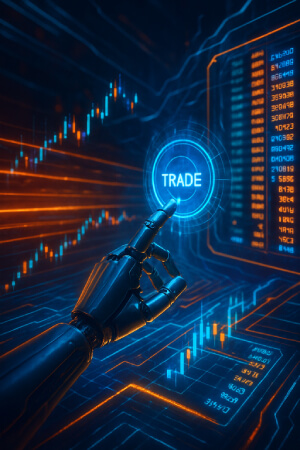Hedging: Reducing Risk Through Intelligent Positioning

Hedging is a key risk management strategy used to shelter the traders' investments against unforeseen market movements. By creating positions on the opposite side, traders might limit the losses while keeping the possibilities of gains. The strength of automation in hedging lies in the real-time observation of open positions as well as market movements. If anything impacts a position, trades can be amended instantly. This practically rules out any loss that might have been incurred. Automated hedging ensures decision-making processes are followed rigidly without emotional interference, which majors are good in themselves, and I am sure they will gain confidence in the most volatile markets. Hedging simply intended as a safety net to balance the portfolio under uncertain circumstances.
Use of AI in Risk Management
Artificial intelligence acts as an important instrument in virtually all hedging strategies nowadays. Given an enormous historical dataset of prices, correlations among different assets, and current volatility conditions, AI systems measure and identify the ideal hedge strategies for trades. For example, if a market is perceived as risky, the AI-based system will automatically buy protective options or enter some counter positions as offsets for contemplated losses. This automation ignores human error and ensures that trades are conducted at the time most optimal for them. An AI system keeps learning from its past data and improving its best predictive ability with time, thereby providing risk management to traders with reliability and nimbleness in traditional as well as cryptocurrency markets.
Practical Examples
While hedging in crypto trading is basically pairing a more volatile altcoin with a stable one, like Bitcoin or USDT, the system can track price changes across exchanges and instantly occur rebalance in order to shield investors from shocks. If the price of the altcoin starts to plummet all of a sudden, the AI system might go on and sell or increase its position so as to reduce exposure, or if the prices start rising, it can keep its exposure to make gains from the market. These automated adjustments help traders efficiently manage risks while remaining invested in situations where stability and profits are otherwise hard to come by in highly volatile markets.
Arbitrage: Exploiting Market Inefficiencies
Arbitrage is an investment venture that profits from price divergences between different markets or exchanges for the same asset. While the visible abstraction is really straightforward-the possibility for legitimate arbitrage needs to be time-sensitive, exact, and vigilantly monitored-areas in which automation and AI sit very comfortably. Human traders will try to capitalize on opportunities in an instance, but it's hard for them to do so in any meaningful way. The AI, however, will look at many markets simultaneously and kick off trades in an instant. Traders stand to make profits with low-market exposure by exploiting such inefficiencies of the price. In fast-moving markets like cryptocurrencies, automated arbitrage is of paramount interest, mainly because delays of just a few few seconds may mean no profit at all from the transaction.
Automation in Arbitrage
Arbitrage renders AI and algorithms indispensable today since they scan dozens of exchanges and trading pairs simultaneously. Upon detection of price discrepancy, trades are executed within milliseconds; thus, the window of opportunity closes before the market self-corrects. Automation eliminates delays-hence-prone-to human errors-giving rise to more reliable and consistent execution. Furthermore, AI will keep a continuous track of market liquidity, trading fees, and risk factors, making dynamic adjustments to strategies. Hence, traders will concern themselves with strategy oversight rather than with manual executions, allocating more efficiency and profitability to markets where speed matters.
Types of Arbitrage
There exists many strategies behind arbitrage with differing mechanics. Spatial arbitrage implies purchasing an asset on one exchange where it is said to be a little bit cheaper and then selling it on another where the price is determined to be slightly more. Triangular arbitrage detects some price differences between three assets within a single market and is mostly practiced with respect to forex and cryptocurrencies. Automation allows these trades to be realized in an almost instant manner, boosting the potential for profit while also minimizing exposure to market risk. In turn, an AI takes over such a complicated job of calculations and execution speed, allowing traders to profit from small disturbances occurring rapidly and too quick to be exploited manually.
Scalping: Small Gains, High Frequency

Scalping is a trading technique involving the aggressively close of positions for minuscule profits over and over again throughout the day. Most of the time, scalping benefits from high trade frequencies rather than large profits from single trades, and this requires greater attention and swift executions. It thus becomes impossible for scalpers to trade successfully in volatile markets because of the speed and accuracy required. Automations help the trading bots in constantly monitoring market conditions and acting instantaneously upon the coming of a trading opportunity. By attempting for incremental profits, scalping can develop a profile of steady income over periods. Inaccurate trade execution can be averted with AI-supported trades in a consistent manner, with adequate accuracy that reduces lapses caused by fatigue or delayed decision-making.
How AI Enhances Scalping
Price changes, order book depth on specific exchanges, and market sentiment are all analyzed in real time by Artificial Intelligence-powered trading systems, thus improving scalping. Algorithms sift through the plethora of orders for micro-opportunities lasting just fractions of seconds and carry out trades within milliseconds. Such quick trades are thus able to take profits on small movements before the market reacts. AI also takes care of transaction costs and trades with a volume and timing that ensure a profit. Also, if the AI keeps finding patterns in market behavior, it improves predictions and decision-making over time. This automation disallows any conflicting human emotional bias to interfere and provides an efficient approach to what high-frequency trading must otherwise undergo manually.
Scalping in Practice
In high-volatility markets such as cryptocurrency, small price fluctuations occur all the time. Automated scalping systems can make dozens, even hundreds, of trades per hour, thus repeatedly cashing in on these tiny profits. For instance, the price of an altcoin might inch a few cents up or down in either direction, and in those few seconds, AI bots would act to buy low and sell high, doing this several times throughout the day. These tiny profits build overtime into significant gains, all the while without any fatigue, stress, or mistakes associated with manual trading. Scalping automations allow for maximum consistency, speed, and efficiency, all of which are a boon for any trader interested in capitalizing on frequent, fuss-free market ups and downs.
Trend-Following: Riding Market Momentum
Being an adaptive force of the markets, the concept of trend-following-based strategies attempts to induce behavioral alignment with prevailing market conditions-so buying when asset prices are rising and selling when prices are falling. Hence, trend followers put emphasis on a momentum that is sustained rather than on a reversal. While in theory the construction should be simple, to follow trends for a profit an operator needs a timely detection tool and an execution system-requirements that are difficult to implement manually. Automation allows the continuous observation of markets and trade analysis, thereby preventing any delays. These AI-assisted systems allow an instant reaction to the formation of any new trend so that gains can be maximized, losses minimized, and human errors eliminated. An automated trend-following system ensures that trades remain disciplined and consistent while trading different asset classes like stocks, forex, and cryptocurrencies.
AI-Powered Trend Analysis
For trend-following, AI analyzes a huge historical market dataset along with data streaming into the market, such as price patterns, trading volume, and technical indicators. Machine learning systems consequently trace very subtle trends which may signify either the beginning or the end of a trend. Once in operation, they keep adapting to market condition changes, thus improving their predictive abilities and timing of trades. AI can integrate other data sources, such as social sentiment and news signals, in their decision-making process. Thus, traders are empowered to become better-informed and more systematic in their approach to trend-following, being able to time their entry/exit at the right opportunity and ultimately raising their chances of catching sustained market momentum.
Benefits of Automation
Automated trend-following systems operate 24/7, executing all trades after receiving and reacting to given signals with no human intervention. These decisions remove any sort of emotional response that may otherwise cause premature exits and overtrading. AI, hence, ensures consistent execution while dynamically adapting to market changes and sheltering its strategy updates as trends shift. The trader need not mind watching markets day and night, as the system monitors multiple assets and signals all at once. Automation keeps the system responding faster to shifts, thus limiting losses. In all, trends with AI suit a disciplined, effective, and scalable method that places traders to chase momentum while limiting emotional and operational errors in fast-paced markets.
Challenges and Considerations of Automation
The use of automation in trading comes with both benefits and drawbacks. If technical failures, system malfunctions, and algorithmic errors are not immediately addressed, there can be losses that were never supposed to occur. Alternatively, certain abrupt market events and circumstances may have an economy inflicting drastic volatility unforeseen to cause automated strategies to underperform. The systems need regular monitoring, backtesting rigorously on the historic data, and updates to maintain adaptability with market-changing conditions.
Navigating Markets with Smarter Tactics
Automated trading strategies changed financial markets with their ability to act fast and immeasurably precise in maintaining risk that manual trading lacks. In hedging, the portfolio is protected; in arbitraging, one exploits that inefficiency. Scalping is used for tiny price movements, while trend-following is used to capture momentum. The interaction of all these strategies encourages investors to face complex markets ever so confidently. Proper strategies, implementation, monitoring, and adaptation are the key factors contributing to consistent performance.
Quick Links
💻 AI is reshaping crypto trading with bots analyzing real-time data better than humans. Automated portfolios are the future for quick decisions. #CryptoBots #AITrading #CryptoAutomation 🤖 pic.twitter.com/GIQjMAi5wJ
— Wirer 💓 (@wirer_w) November 10, 2025
🚨BREAKING: AI can now replace an entire trading team worth $300K.
— Hasan Toor (@hasantoxr) July 24, 2025
It scans markets 24/7, runs strategies, and executes faster than any human.
Here’s how it works👇 pic.twitter.com/q43JVp5ZsW
🚨BREAKING: AI can now replace an entire trading team worth $300K.
— Hasan Toor (@hasantoxr) July 24, 2025
It scans markets 24/7, runs strategies, and executes faster than any human.
Here’s how it works👇 pic.twitter.com/q43JVp5ZsW